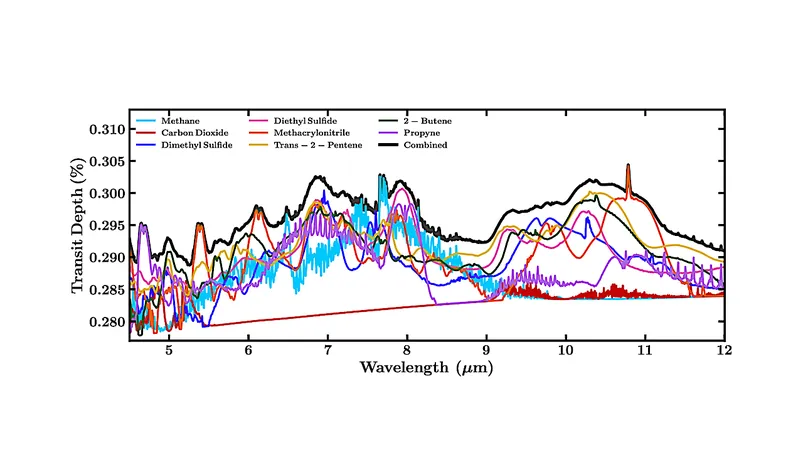
Unlocking the Secrets of Exoplanet K2-18 b: Are We Near Finding Life?
2025-05-16
Author: Rajesh
Revolutionary Discoveries in Exoplanet Research!
The James Webb Space Telescope (JWST) has made headlines by capturing the first transmission spectrum of the intriguing habitable-zone exoplanet, K2-18 b. This groundbreaking achievement marks a significant leap forward in understanding the atmospheres of low-mass exoplanets, particularly those that are temperate.
Potential Signs of Life?
Recent observations suggest the presence of methane and carbon dioxide in K2-18 b's atmosphere. But that’s not all! The detection of dimethyl sulfide (DMS) and dimethyl disulfide (DMDS)—both of which could be biosignatures—raises exciting questions about the potential for life beyond Earth. However, confirming these findings requires more robust data.
A Comprehensive Search for Molecules!
In a quest to expand our understanding, researchers conducted an extensive search for other chemical species within K2-18 b's atmosphere, analyzing a whopping 650 different molecules. This range includes biological, inorganic, and even man-made gases, providing a thorough overview of what could be present.
What Did They Find?
Utilizing three distinct metrics—mid-infrared and near-infrared spectrometry, alongside probable production sources—researchers identified three promising molecules, including the previously mentioned DMS, diethyl sulfide, and methyl acrylonitrile. These are complex compounds known to originate from biological processes on Earth and lack any significant non-biological sources elsewhere.
The Need for Further Investigation!
While several other candidates showed potential, further observations are crucial to untangle the web of possible trace gases present in K2-18 b. The findings underline an urgent need for continued exploration and theoretical studies to determine the true nature and origins of these intriguing compounds.
Mapping the Atmosphere: A Complex Process!
The study employs sophisticated retrieval methods, comparing various models to validate findings. Advanced retrieval codes like POSEIDON, VIRA, and petitRADTRANS were instrumental in analyzing the data, ensuring the reliability of candidate gas presence and laying the groundwork for future research.
The Future Awaits!
As scientists continue to unravel the secrets of K2-18 b, the tantalizing possibility of discovering life beyond our planet draws ever closer. Each finding not only fuels our curiosity but propels the space exploration frontier forward. Stay tuned as we await more revelations from this exciting exoplanet!


 Brasil (PT)
Brasil (PT)
 Canada (EN)
Canada (EN)
 Chile (ES)
Chile (ES)
 Česko (CS)
Česko (CS)
 대한민국 (KO)
대한민국 (KO)
 España (ES)
España (ES)
 France (FR)
France (FR)
 Hong Kong (EN)
Hong Kong (EN)
 Italia (IT)
Italia (IT)
 日本 (JA)
日本 (JA)
 Magyarország (HU)
Magyarország (HU)
 Norge (NO)
Norge (NO)
 Polska (PL)
Polska (PL)
 Schweiz (DE)
Schweiz (DE)
 Singapore (EN)
Singapore (EN)
 Sverige (SV)
Sverige (SV)
 Suomi (FI)
Suomi (FI)
 Türkiye (TR)
Türkiye (TR)
 الإمارات العربية المتحدة (AR)
الإمارات العربية المتحدة (AR)